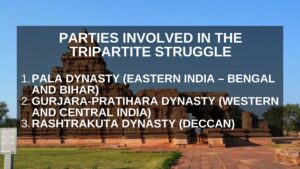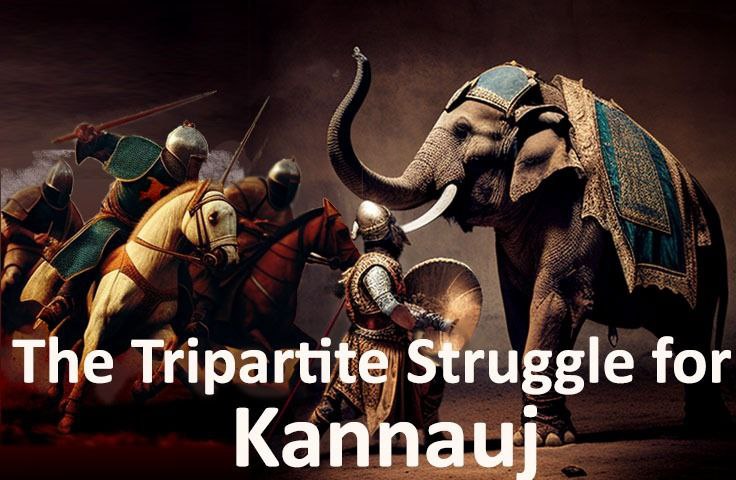The Tripartite Struggle, also known as the Kannauj Triangle Wars, was a prolonged conflict among three major powers of early medieval India: the Palas, the Pratiharas, and the Rashtrakutas. The struggle spanned from the late 8th century to the early 10th century and centered on the control of the strategic city of Kannauj, which was a symbol of prestige and a key commercial hub.
Who Were the Parties Involved in the Tripartite Struggle?
The Rise of Three Powers
After the decline of Harsha’s empire in the 7th century, India saw the emergence of several powerful states in the north, south, and the Deccan. The most prominent among them were:
- Pala Dynasty (Eastern India – Bengal and Bihar)
- Gurjara-Pratihara Dynasty (Western and Central India)
- Rashtrakuta Dynasty (Deccan)
Each of these dynasties sought control over Kannauj due to its political and economic significance.
Download notes of Satavahana Dynasty
The Dynasties Involved
1. The Rashtrakutas
- The Rashtrakutas originated from the Deccan and established themselves as a dominant power in Central India.
- Dantidurga (753 CE) laid the foundation of Rashtrakuta rule by defeating the Chalukyas of Badami.
- The dynasty reached its zenith under Govinda III and Amoghavarsha.
- They were strong patrons of Jainism and Kannada literature.
2. The Gurjara-Pratiharas
- The Pratiharas were Rajput rulers who rose from the Mandavyapura (present-day Mandor, Rajasthan).
- Nagabhatta I (730-760 CE) founded the dynasty and checked Arab invasions.
- Mihir Bhoja (836-885 CE) was its most powerful ruler, expanding the empire to Kashmir.
- The Pratiharas played a crucial role in defending India against Arab invasions.
3. The Palas
- The Palas ruled over Bengal and Bihar.
- Gopala (750 CE) was the founder, elected by local chieftains.
- Dharmapala (770-810 CE) expanded the empire and patronized Buddhism by founding Vikramshila University.
- Devapala (810-850 CE) extended the empire into Assam and Odisha.

The Phases of the Tripartite Struggle
Phase I: The First Battle for Kannauj (Late 8th Century)
- The struggle began when Dharmapala of the Palas installed a puppet ruler, Chakrayudha, in Kannauj.
- Vatsaraja of the Pratiharas opposed this and defeated Dharmapala at Prayaga.
- However, Dhruva of the Rashtrakutas then defeated Vatsaraja, gaining control of Kannauj.
- Unable to consolidate power in the north, Dhruva returned to the Deccan, leaving Kannauj vulnerable.
Phase II: The Second Battle for Kannauj (Early 9th Century)
- Dharmapala took advantage of the power vacuum and reasserted control over Kannauj.
- However, Nagabhatta II of the Pratiharas launched an invasion, defeating Dharmapala in Munger.
- Just as the Pratiharas gained control, Govinda III of the Rashtrakutas attacked and briefly held Kannauj.
- After Govinda III returned south, Nagabhatta II regained control.
The Aftermath: Who Won the Tripartite Struggle?
- By the end of the conflict, the Pratiharas emerged victorious, establishing Kannauj as their capital.
- The Palas retained control over Bengal and Bihar but weakened.
- The Rashtrakutas focused on the Deccan and refrained from northern campaigns.
Causes of the Conflict
- Prestige: Kannauj was a symbol of supremacy in North India.
- Economic Benefits: The city’s strategic location on trade routes made it a commercial hub.
- Weak Local Rulers: The weak kings of Kannauj (Indrayudha, Vijrayudha, Chakrayudha) made it easy for stronger dynasties to assert control.
- Desire for the Title of ‘Lord of Uttarapatha’: Each dynasty wanted to claim this prestigious title.
Impact of the Conflict
- Political Fragmentation: The century-long war weakened all three dynasties, leading to political instability.
- Islamic Invasions: The weakened states made India vulnerable to invasions by Mahmud of Ghazni.
- Decline of the Three Dynasties:
- The Pratiharas lost power as their feudatories became independent.
- The Rashtrakutas declined due to internal conflicts and Chola invasions.
- The Palas weakened due to rebellions and external attacks.
Cultural Contributions of the Dynasties
Literature
- Kannada Literature: Amoghavarsha of the Rashtrakutas wrote Kavirajamarga.
- Bengali Literature: Proto-Bengali evolved under Pala rule.
- Sanskrit Literature: Rajashekhara, the great Sanskrit poet, was in the court of Mahendrapala of the Pratiharas.
Download notes of Mauryan Society UPSC Notes
Architecture
- Pala Style: Developed in Bengal with black basalt sculptures and terracotta temples.
- Pratihara Style: Nagara-style temples such as the Somnath Temple (Nagabhatta II) and Teli ka Mandir (Mihir Bhoja).
- Rashtrakuta Style: Vesara-style temples; Kailash Temple at Ellora (Krishna I).
The Tripartite Struggle was a defining power struggle in early medieval India. Though the Pratiharas emerged victorious, all three empires eventually declined. The prolonged conflict weakened the region, paving the way for foreign invasions. However, these dynasties left a lasting legacy in Indian art, architecture, and culture.
FAQs on the Tripartite Struggle
- What was the Tripartite Struggle?
- A power struggle between the Palas, Pratiharas, and Rashtrakutas over Kannauj (790-1162 AD).
- Who were the parties involved?
- The Pala Dynasty (Bengal), Gurjara-Pratihara Dynasty (Rajasthan & Central India), Rashtrakuta Dynasty (Deccan).
- Who started the struggle?
- The conflict began when Dharmapala of the Pala Empire installed Chakrayudha as a puppet ruler in Kannauj.
- Which king won the Tripartite Struggle?
- The Pratiharas, under Nagabhatta II and Mihir Bhoja, eventually controlled Kannauj and ruled for nearly three centuries.


